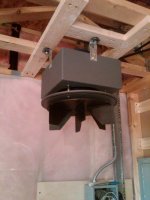I got my CV last week and I am now mounting it. In CV's installation instructions and pictures there is no mention of putting any isolation/cushioning material between the wall mounting support (side brackets and wall back plate. However, in viewing a number of the installations in the Photo Gallery (thanks much guys), I saw several installations that had some foam between the side brackets (2x4s) and the main horizontal mounting frame plate (MDF) which supports the motor.
I have decided to put some foam on top of the 2x4 brackets. (Its the dense stuff that I am walking on in from of my workbench to cushing my joints for standing. A Sam's purchase made for this use.)
1. The instructions recommend securing the 2x4 brackets to the motor mounting frame. If you used an isolating material as discussed above, did you secure the 2x4 brackets to the motor mounting frame plate?
2. If so, what method did you use to secure the motor mounting frame plate? It can't go anywhere except forward away from the wall if it was left un-secured. I would think that using screws would be too rigid, but that loose bolting or adding a stop at the end of the support bracket would work well. Has anyone just left this mounting float on the isolation without securing it? If so, has it moved around?
3. Has anyone actually proved (know for sure) that using the isolation material actually reduces noise and vibration? (Intuitively I would think that it would reduce vibration transmission and therefore noise, but is there any proof "in this pudding"?)
Thanks in advance from this newcomer. Can't wait to getting this thing going.
Ed
I have decided to put some foam on top of the 2x4 brackets. (Its the dense stuff that I am walking on in from of my workbench to cushing my joints for standing. A Sam's purchase made for this use.)
1. The instructions recommend securing the 2x4 brackets to the motor mounting frame. If you used an isolating material as discussed above, did you secure the 2x4 brackets to the motor mounting frame plate?
2. If so, what method did you use to secure the motor mounting frame plate? It can't go anywhere except forward away from the wall if it was left un-secured. I would think that using screws would be too rigid, but that loose bolting or adding a stop at the end of the support bracket would work well. Has anyone just left this mounting float on the isolation without securing it? If so, has it moved around?
3. Has anyone actually proved (know for sure) that using the isolation material actually reduces noise and vibration? (Intuitively I would think that it would reduce vibration transmission and therefore noise, but is there any proof "in this pudding"?)
Thanks in advance from this newcomer. Can't wait to getting this thing going.
Ed



